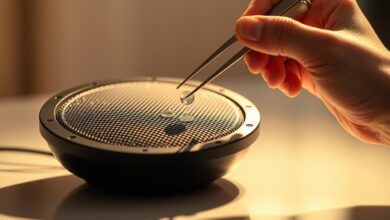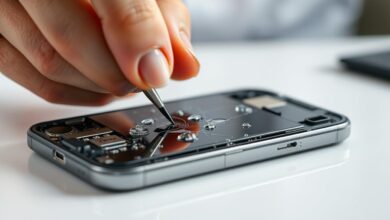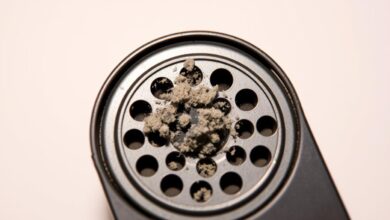how to get water out of speakers
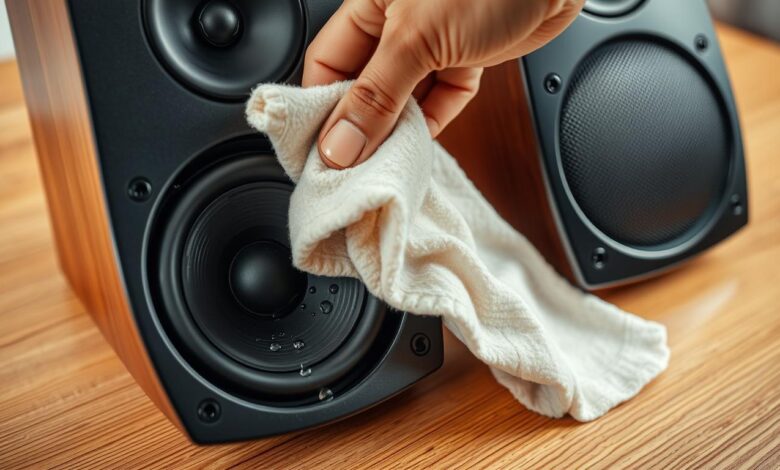
Water can harm your device’s speakers, causing bad sound or no sound at all. It’s key to know how to remove water from speakers to avoid damage and get back good sound.
I’ll show you how to safely get water out of your device’s speakers. We’ll follow a few easy steps. These steps can help keep your speakers working right.
Key Takeaways
- Understanding the risks of water exposure to device speakers
- Simple techniques for removing water from speakers
- Preventive measures to protect your device’s speakers
- Restoring sound quality after water exposure
- Importance of acting quickly to minimize damage
Understanding Speaker Water Damage
It’s important to know how water affects speakers to avoid damage. Water and electronics don’t mix well. When speakers get wet, they can face many problems.
How Water Affects Speaker Components
Water can harm speaker parts in different ways. It can cause short circuits in the electrical parts, leading to issues or failure. The voice coil, a key part, can rust from water, affecting sound quality.
Water can also damage the speaker cone. It makes the cone heavy and lose its shape. This can cause sound distortion or loss.
Water can get into the amplifier or other electronic parts, causing them to fail. It can also lead to mold and mildew inside the speaker, making damage worse.
Common Causes of Water Damage in Speakers
Speakers can get wet in many ways, like accidental drops or being in the rain. Accidental drops are common, especially for portable or Bluetooth speakers near water or in bathrooms. Being outside in the rain can also cause damage.
Using speakers in humid places can also cause moisture buildup inside. This can damage them over time. Knowing these causes helps prevent water damage to your speakers.
Assessing the Severity of Water Damage
Before you try to dry out wet speakers, you need to check how bad the water damage is. This first check will help you know what steps to take next. It makes sure you use the best ways to fix the speakers.
Identifying the Type of Water Exposure
The kind of water that got into the speakers matters a lot. Freshwater, saltwater, and dirty water can all cause different kinds of damage. Saltwater, for example, is very bad because it can rust metal parts. Knowing what kind of water it is helps you figure out how to dry and fix the speakers.
Evaluating Internal vs. External Damage
It’s important to tell if the water damage is inside or outside the speakers. Damage on the outside is easy to see, but damage inside is hidden. Knowing if the water got inside helps you decide how much you need to take apart to dry it out.
Risk Assessment for Different Speaker Types
Speakers can be more or less likely to get damaged by water. Portable speakers, for example, are often used outside and might get wet more. But home speakers are usually safer because they’re used less in wet places. Knowing the risk helps you choose the best way to dry and fix the speakers.
| Speaker Type | Risk Level | Recommended Action |
|---|---|---|
| Portable Speakers | High | Immediate disassembly and drying |
| Home Entertainment System Speakers | Low | External drying and inspection |
| Bluetooth Speakers | Medium | Drying with silica gel packets |
Immediate Actions to Take When Speakers Get Wet
When your speakers get wet, you must act fast. Water and electronics don’t mix well. It can cause short circuits, corrosion, and damage if not fixed quickly.
Power Off and Disconnect Immediately
First, turn off your speakers right away. This stops short circuits that can harm them more. If they’re plugged in, unplug them. For battery speakers, take out the batteries to avoid electrical surges.
Remove Batteries and External Components
It’s important to take out batteries and any parts you can remove. This includes grills or covers. It helps keep water out of the speaker’s inside parts.
Initial Water Removal Techniques
Try to shake off the water gently. Don’t shake too hard to avoid more damage. Use a soft cloth or towel to soak up water. Don’t use heat like hair dryers, as it can harm the speakers.
| Action | Purpose | Precaution |
|---|---|---|
| Power off and disconnect | Prevent short circuits | Avoid electrical shock |
| Remove batteries and external components | Reduce water penetration | Handle components with care |
| Gently shake and pat dry | Remove visible water | Avoid vigorous shaking |
By acting fast, you can fix your wet speakers. Next, you’ll need to dry them out and possibly do more repairs.
How to Get Water Out of Speakers: Step-by-Step Guide
To get water out of your speakers, follow this step-by-step guide. This will help you fix your speakers by dealing with the water damage step by step.
Disassembling Speakers (When Possible)
If you can take apart your speakers, it’s a key step in drying them. Start by removing any grills or covers to see the inside. Be careful and check your speaker’s manual if you’re not sure how to take them apart.
Caution: Not all speakers can be taken apart. Always check your speaker’s manual or the manufacturer’s instructions before you start.
Removing Visible Water
Gently tilt your speakers to get rid of any water you can see. Use a soft, dry cloth to pat the outside and soak up moisture. Don’t use heat or blow air into the speaker to avoid pushing water deeper inside.
Drying the Speaker Housing
After getting rid of visible water, dry the speaker housing. You can use silica gel packets or uncooked rice to soak up moisture. Put your speaker in a container with the desiccant material, making sure it’s fully covered. Let it sit for at least 48 hours.
| Drying Method | Effectiveness | Precautions |
|---|---|---|
| Air Drying | Moderate | May take longer; ensure good airflow |
| Silica Gel | High | Avoid inhaling silica gel dust |
| Rice | Moderate | May leave dust; not as effective as silica gel |
Effective Methods for Drying Speaker Components
When speakers get wet, there are ways to dry them without too much damage. It’s important to act fast and pick the right method for your speaker’s type and how wet it is.
Air Drying Technique
A simple way to dry speakers is air drying. Just put the speaker in a place with good air flow. Make sure it’s set up so water can’t get back in.
To help air dry faster, use fans. But don’t blow air right into the speaker. This could push dirt inside.
Using Silica Gel Packets
Silica gel packets are great at pulling moisture out of the air. Put the speaker in a box with these packets and seal it. This creates a dry space.
This method works well for small speakers or parts. You can find silica gel packets at hardware stores or online.
Rice Method: Effectiveness and Limitations
The rice method uses uncooked rice to soak up moisture. It’s a bit messy and can clog speaker openings with rice grains.
To use rice, make sure the speaker is fully covered. Seal the container to keep moisture out. But, it’s not as good as silica gel packets.
Using Compressed Air Safely
Compressed air can dry speakers, but safely. Don’t spray it into the speaker openings. This could push dirt in or harm the parts.
Instead, gently blow compressed air over the speaker. This removes water and dirt. Be careful not to use too much pressure, which can damage the speaker.
Using Sound Frequencies to Expel Water
One cool way to get water out of speakers is by using sound frequencies. This method uses sound waves to push water out of the speaker’s parts.
How Low-Frequency Sounds Remove Water
Low-frequency sounds are great at getting water out of speakers. They make vibrations that knock water off the speaker’s surface and inside. This happens because the sound waves create pressure that pushes the water out.
Benefits of Using Low-Frequency Sounds:
- Effective for removing water from small crevices
- Can be used in conjunction with other drying methods
- Non-invasive and doesn’t require disassembling the speaker
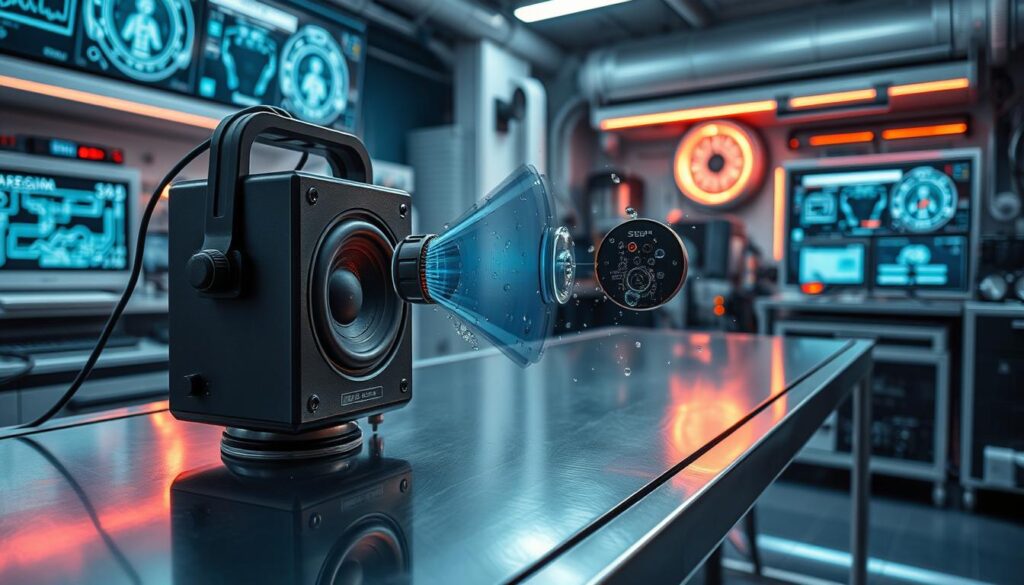
Apps and Tools for Water Ejection
There are apps and tools that can make the sound frequencies needed to get rid of water. For example, you can use a frequency generator app on the Google Play Store to make the low-frequency sounds.
| Tool/App | Description | Platform |
|---|---|---|
| Frequency Generator | Generates various sound frequencies | Android |
| Sound Frequency App | Produces low-frequency sounds for water ejection | iOS |
| Online Frequency Generator | Web-based tool for generating sound frequencies | Web |
Creating Your Own Water Ejection Tones
If you can’t find an app or tool, you can make your own water ejection tones. You can use audio editing software to make a tone. Play it through your device’s speaker. The tone should be in the low-frequency range, between 20 Hz to 200 Hz, to work well.
Tips for creating effective tones:
- Use a frequency within the low-range spectrum
- Adjust the amplitude to a comfortable level
- Play the tone for an extended period to ensure thorough water ejection
Specialized Techniques for Different Speaker Types
Removing water from speakers depends on the type, like smartphones, Bluetooth, and car audio. Each faces unique challenges and needs specific steps to dry out.
Smartphone and Tablet Speakers
Smartphone and tablet speakers are small and delicate. Use desiccants or silica gel to soak up moisture. Also, tap the device gently with the speaker down to push out water.
Bluetooth and Portable Speakers
Bluetooth and portable speakers are easier to work with. If you can take them apart, let them dry in the air. Use a soft cloth to pat them dry and remove any water you see.
Home Entertainment System Speakers
Home speakers are bigger and more complex. To dry them, use a fan on low or a cool hairdryer. This helps water evaporate without harming the parts.
Car Audio Speakers
Car speakers are tricky because of the car’s humidity and temperature changes. Make sure they’re dry before putting them back. Use compressed air to remove water, but be careful not to push it in further.
For any speaker, being patient and gentle is crucial. Experts say, “The key to fixing water-damaged speakers is quick and gentle drying.”
Dealing with Saltwater Damage
Saltwater can really hurt speakers, needing special care. Saltwater damage goes beyond just getting wet. It’s corrosive and can harm the speaker’s parts over time.
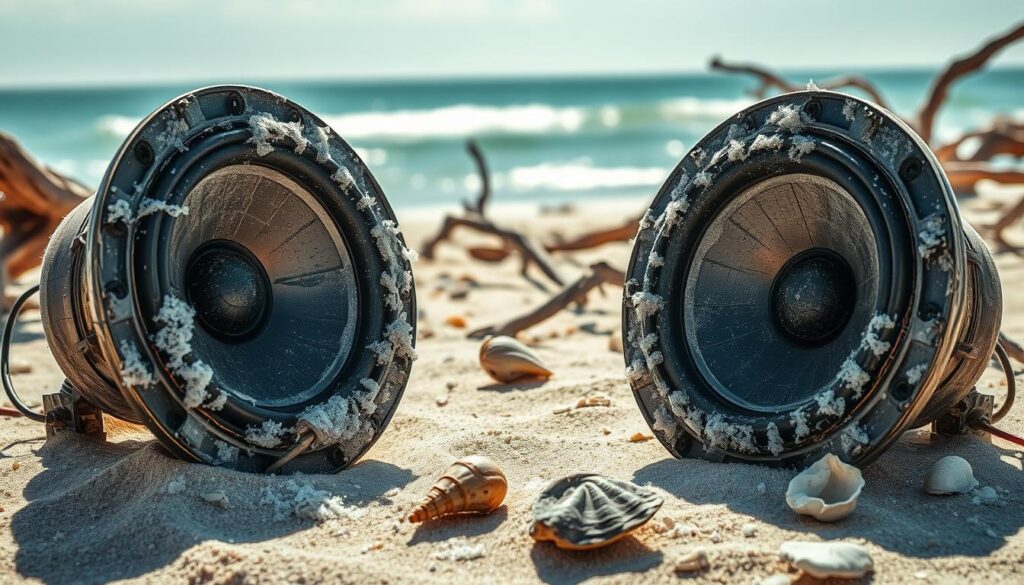
Why Saltwater Is More Damaging
Saltwater is worse than freshwater because it has lots of salt. This salt can corrode metal parts in the speaker. If not fixed quickly, it can cause lasting damage.
Special Cleaning Procedures for Saltwater Exposure
To fix saltwater damage, clean the speaker well. First, rinse the outside with fresh water to get rid of salt. Then, use a soft brush or cotton swab to clean out salt from tight spots.
For a deeper clean, mix distilled water with white vinegar. But be careful not to touch any electrical parts.
Neutralizing Salt Residue
After cleaning, get rid of any salt left to stop corrosion. Use water and baking soda or a product made for this. Make sure it doesn’t touch electrical parts. Let the speaker dry completely before you test it.
Professional Cleaning Solutions and Products
When dealing with water-damaged speakers, using professional cleaning solutions is key. The right products can greatly improve the speaker’s sound and function.
Electronic Contact Cleaners
Electronic contact cleaners are made to clean speaker parts without harm. They dry fast and leave no residue, which is vital for the speaker’s circuitry. Use these cleaners on contacts and switches for the best results.
Isopropyl Alcohol Cleaning Method
The isopropyl alcohol method is also effective for cleaning water-damaged speakers. Isopropyl alcohol can dissolve grime and corrosion from water. Use a cotton swab with isopropyl alcohol on the affected areas carefully.
Be careful with isopropyl alcohol, as it can harm some speaker materials. Always check if it’s safe for your speaker’s parts before using it.
Commercial Water Damage Restoration Products
Many commercial products are made to fix water-damaged electronics, like speakers. These can include sprays to dry out moisture or solutions to stop corrosion. When picking a product, make sure it’s safe for your speaker and follow the instructions.
Using these professional cleaning solutions and products can help fix water-damaged speakers. Whether it’s electronic cleaners, isopropyl alcohol, or commercial products, the goal is to clean carefully to avoid more damage.
Preventing Corrosion and Long-term Damage
Stopping corrosion and long-term damage is key to fixing your speakers after water damage. Water damage can cause lasting problems if not fixed right.
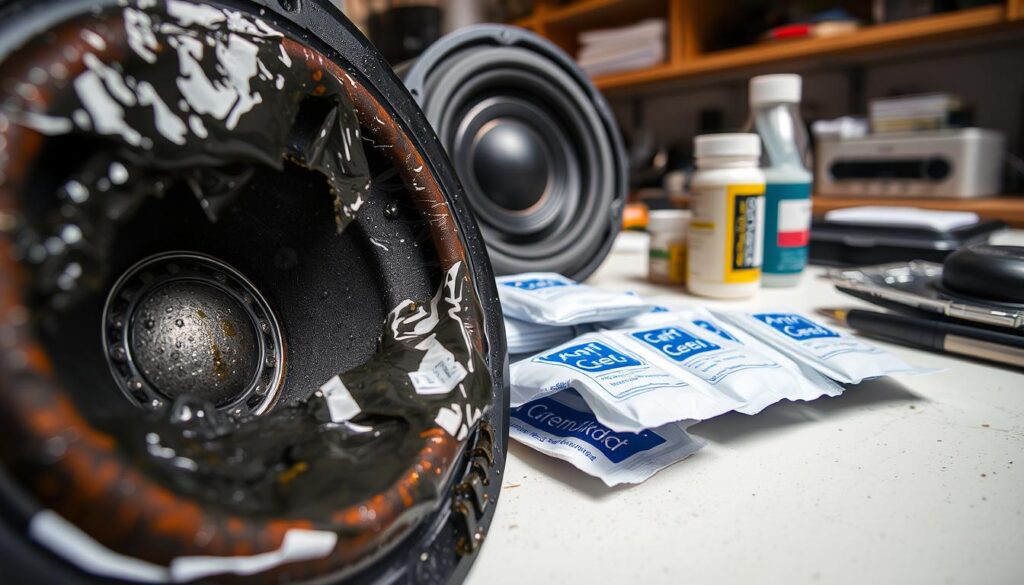
Applying Protective Coatings
Using protective coatings on parts that can rust is a good idea. You can use anti-corrosion sprays or silicone-based coatings on metal and circuit boards. These coatings block moisture and prevent damage.
Humidity Control for Damaged Speakers
Keeping the humidity low around your speakers is very important. High humidity can make corrosion and damage worse. A dehumidifier in the room where your speakers are drying helps keep the air safe.
Preventing Mold and Mildew Growth
Mold and mildew can grow in damp places and harm your speakers. Good airflow and keeping the area clean can stop this. If needed, a fungicide can be used, but always follow the instructions.
| Method | Description | Effectiveness |
|---|---|---|
| Protective Coatings | Applying anti-corrosion sprays or silicone-based coatings | High |
| Humidity Control | Using a dehumidifier to reduce moisture | High |
| Mold Prevention | Ensuring good airflow and using fungicides if necessary | Medium |
Testing Speakers After Water Removal
After removing water from your speakers, it’s important to test them. This step helps find any problems caused by water. It’s crucial for your speakers to work right.
Gradual Power-Up Process
Start by checking your speakers for damage or corrosion. Then, plug them in or turn them on. But don’t play music at full volume right away.
Begin with a low volume to see if there’s distortion or odd sounds. This careful step is the first in testing your speakers.
Audio Quality Assessment
After turning on your speakers, listen to the sound quality. Play different music or audio to check for clarity and any odd noises. If you hear crackling or muffled sounds, it might mean your speakers need more drying or have internal damage.
Signs That Further Drying Is Needed
If you find distortion, low volume, or no sound, it’s a sign of more drying needed. You might need to dry them again or use special drying methods. This ensures your speakers are dry and work well.
When to Seek Professional Help
Many water-damaged speakers can be fixed with DIY methods. But, some cases need a pro’s touch. If your speakers won’t work after trying DIY fixes, it’s time to call a professional.
Signs of Irreparable Damage
Some signs show your speakers can’t be fixed. Look out for:
- Visible corrosion on internal parts
- No improvement after drying and testing
- Unusual noises or distortion when playing sound
- Complete failure to make sound
If you see these signs, your speakers likely have irreparable damage.
Finding Qualified Repair Services
Finding the right help for waterlogged speakers repair is key. Look for:
- Electronics repair shops with wet speakers solution experience
- Authorized service centers for your speaker’s brand
- Technicians with good reviews and the right skills
Make sure the service offers a diagnosis before fixing anything.
Cost Considerations: Repair vs. Replacement
Choosing between fixing or replacing your speakers depends on cost. If repair costs more than 50% of the original price, it might be cheaper to buy new ones. Consider the speakers’ age, condition, and future problems when deciding.
Conclusion
Water damage to speakers can be stressful, but quick action helps a lot. We’ve looked at ways to remove water from speakers. This includes immediate steps, detailed guides, and special methods for different speakers.
First, turn off the device and remove any accessories. Use air drying, silica gel packets, or sound waves to get rid of water. But, don’t use too much heat, blow air, or shake it hard. These can harm your speaker more. For tips on drying a wet phone, check out wikihow’s guide.
Knowing how to remove water from speakers helps a lot. It can save your device from damage. Whether it’s a phone, Bluetooth speaker, or home system, act fast, be careful, and use the right drying methods.
FAQ
How do I know if my speakers are damaged beyond repair?
Look for severe corrosion, saltwater damage, or major physical harm. If you see these signs, it’s time to get a pro’s opinion.
Can I use a hair dryer to dry out my water-logged speakers?
No, hair dryers can push water deeper or harm your speakers with too much heat. Instead, try air drying or silica gel packets.
What is the best method to remove water from smartphone speakers?
Gently tap your phone, use sound to push out water, or try the rice method. But be careful not to push water in further.
How can I prevent water damage to my Bluetooth speakers in the future?
Keep your Bluetooth speakers dry by avoiding water and using a waterproof cover. Also, check them regularly for damage.
Are there any specific products that can help in drying out wet speakers?
Yes, silica gel packets, electronic cleaners, and water damage products can help. Isopropyl alcohol is also good for cleaning, but use it carefully.
Can saltwater damage be reversed in speakers?
Saltwater damage is hard to fix because it’s corrosive. But, quick action like rinsing with fresh water and using special cleaners can help.
How do I test my speakers after they’ve been dried?
Start with low volume and check the sound quality. Look for any distortion or odd sounds that mean they need more drying.
Is it worth repairing water-damaged home entertainment system speakers?
It depends on the damage and repair costs. If the damage is minor and the cost is low, fixing them might be best.
Can I use compressed air to dry out my speakers?
Compressed air can dry speakers, but use it safely. Avoid pushing debris in or damaging your speakers with too much air.
What are the signs that my speakers need professional repair?
Look for distortion, no sound, or visible damage. If you’re not sure, it’s best to get a professional’s help.
